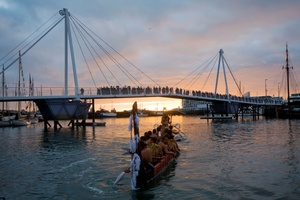Barefoot in our city
David Irwin ventures down to Auckland’s Wynyard Quarter on opening morning and relishes the prospect of a precinct that offers opportunities to connect with the water and play in the sand.
At dawn several weeks ago I gathered with a crowd to watch the opening of the most important new space for Aucklanders since the development of the Viaduct Basin.
I watched as the waka padded in, the wero was called, and the new bridge connecting the city with Wynard Quarter lowered over the Viaduct Harbour. I watched the sun rise over the Waitemata, reflecting off the new events centre and the wharf sheds smelling of coffee and scones. I watched the tide rise over the belly of the new steps at Karanga Plaza. I walked through the newly planted groves on Jellicoe Street, watched children explore the shells and ‘kina’ of the playground and listened to art installations amplifying the sounds of the harbour and seafloor. And I listened to the speeches in English and Te Reo.

I had witnessed perhaps one of the most important events in Auckland’s public space history, the reclaiming of our waterfront. The linking of the waterfront from east to west, Quay Street to Westhaven. It is the first significant move in the opening up of the “Tank Farm” land, and the most significant release to the public of a piece of our coastal edge that reconnects the city with its harbour.
However, it was a very simple action that gave me the most inspiration that morning. It was the action of our mayor as he dipped his toes and ankles into the water and stood on the tidal steps at dawn, immersed in the Waitemata. To me this symbolic gesture clearly demonstrated an understanding of our place and culture, of what it is to be a New Zealander, an Aucklander from Tamaki Makaurau, standing barefoot in our city.
So often our public spaces do not make the powerful design moves that are grounded in the place and reflect our culture; instead they are too often over-designed and preoccupied with materials and elements that belong anywhere and nowhere. It is the ability to actually stand in the water, not just look at it from the protection of the wharf, that really connects us with the harbour. And it is the ability to play in the sand, not in bark chips, that connects the waterfront playground with the waterfront. It is the ability for us to contemplate the future while still seeing our past
As designers we should strive to make emotional and physical connections with place through our work, to allow New Zealanders to express their identity. To do this we need to be able to understand our place and our culture, to feel it, value it, decipher it, reinterpret it, and build it. As designers of New Zealand’s public space we are responsible for achieving this, often in spite of the constraints of the brief and the budget.
At Wynyard Quarter, the people of Auckland have been quick to embrace the new harbour edge, but it is not the cafes and bars that are the main attraction – it is the Waitemata.
In my opinion actions speak louder than words, and this does not always cost more money. For me, what counts is the sea; it is getting down to the sea, walking along the wharf edge without being accosted by beer and bars, and the ability to fish from a pier with my daughter that counts. Wynyard leaves space for these simple actions, leaves some of our history intact, and allows the city to engage with the harbour.
We New Zealanders are not really fussy or showy; let’s keep our design clear and real, like walking barefoot in the sand or simply standing in the sea.










